|

For my Meowmie
|

Military Women Take 200-Year Trek Toward Respect, Parity
By Rudi Williams
American Forces Press Service
WASHINGTON -- Today's military women are doctors, lawyers, pilots,
heavy equipment operators, air traffic controllers, paratroopers,
forklift operators and military police. But women haven't always enjoyed
such prominence in the military.
It took more than 220 years and many trials, tribulations and
indignities for women to reach their present plateau in military
service, said retired Air Force Brig. Gen. Wilma L. Vaught.
They've climbed from being cooks, laundresses and nurses with no
rank, to generals, admirals, astronauts, pilots, ships' captains, heavy
equipment operators, administrators and much more, Vaught said in an
interview with the American Forces Press Service. She is president of
the board of directors of the Women in Military Service for America
Memorial Foundation.
Vaught said she's not one to dwell upon the past, noting there's too
much to be excited about today and the future. But it's important for
military women today to be aware of their history, she said, quoting a
Chinese maxim: "When drinking the water, don't forget who dug the
well."
"Many women don't understand today's military isn't the way it
has always been for women," said Vaught. "If you're going to
understand where you need to go, you need to understand where you've
been."
It dismays her when women say all the problems women encountered in
the military since the Revolutionary War have been solved -- especially
those who say, "I've never been discriminated against."
"They haven't really looked around them and don't really
understand that all the problems are not solved," she said.
"If they've just come into the military, they may believe there
isn't any discrimination. But as they get a little further downstream
they'll get a little wiser and understand how discrimination is
practiced today vs. another time."
She quickly added, "But it's still so much better than it was
when I joined the Air Force in 1957. There's a greater acceptance --
respect -- today, and women are here to stay."
Vaught's historical view starts with the American Revolution, where,
she noted, there was no place for women soldiers. "Some women
wanted to serve their country so badly, they disguised themselves as
men," she said.
The military has historically recognized women's value during periods
of crisis, but only for nursing and household-type duties, she said. For
example, problems of caring for sick and wounded soldiers prompted the
Continental Congress to authorize Gen. George Washington to hire matrons
at a rate of one or two per 100 soldiers.
Other women went along with their husbands as nurses, laundresses and
cooks, which held true for about 100 years, Vaught said.
The Civil War focused attention on women again because of the need to
care for throngs of sick and wounded soldiers, Vaught said.
"I find the requirements to serve as a nurse during the Civil
War amusing," Vaught said with a hearty laugh. "They had to be
over 30, plain-looking and had to wear dark clothes. Obviously, they
didn't intend for nurses to be too attractive." Ironically, those
standards were set by Dorthea Dix, a woman the Union Army hired to
select women to serve as contract nurses. Many women also volunteered.
"Interestingly," Vaught said, "the standards didn't
say anything about nursing abilities."
She said there is no evidence the Confederates hired contract nurses,
but women served so it's assumed they were volunteers -- except for the
documented case of Sally Tompkins. The Confederates commissioned her as
a captain to run a hospital in Richmond.
Vaught also pointed out a famous Union nurse, Mother Mary Ann
Bickerdyke, who worked tirelessly to care for wounded soldiers on the
battlefield and ran soup kitchens.
A native of Cairo, Ill., Bickerdyke followed Union forces from
battlefield to battlefield. "Several generals tried to get rid of
her, but by the end of the war, they recognized the importance of the
service she was providing," Vaught said. "According to
stories, when (Union Army Gen. William T.) Sherman rode into Atlanta,
she was there riding through on a horse too. She had been
accepted."
Another little-known fact is that Civil War nurses established the
first military system to get medical supplies to the battlefields, she
noted.
During the Spanish-American War, Vaught said, the Daughters of the
American Revolution recruited women to work for the Army as contract
nurses. "That was a real breakthrough because it was the first time
the Army officially included women in a cohesive unit." The women
did so well, the Army decided to form a permanent Army Nurse Corps in
1901, she said. The Navy followed suit in 1908.
Both services set professional nursing qualification standards, but
the women got no rank, no command authority and no retirement plan. And
if authorities found out about them, women who were married or getting
married were immediately discharged, Vaught pointed out.
The Navy broke its nurse-only tradition during World War I and
accepted women as yeomen. Vaught said some 12,500 women, including some
17-year-old graduates of finishing schools and clerical schools, were
recruited to perform clerical duties. "No one seems to have said
they had to have parental consent or had to be 18, 19 or 21," she
said.
She said women were accepted in the Naval Reserve and given rank.
Most were almost immediately promoted to yeoman first class, whereas men
had to work their way up through the ranks. "They gave women credit
for their skills and talent, but didn't do that for men," she said.
The Army sent about 300 women in uniform to France as Signal Corps
telephone operators. "They were promised they'd become regular Army
soldiers and receive the same veterans status as men, but that didn't
happen," Vaught said. Those women later waged a 58-year-long battle
to get what they'd earned, she said, and most were dead by the time
Congress made good on the promises in 1977.
Shortly after World War I, the Army gave its nurses relative rank up
to major, but they couldn't command men, Vaught noted. "At the
start of World War II, Army and Navy women had relative rank, but didn't
have real status in the military."
During World War II, thousands of women lined up to join the Women's
Army Corps; the Navy WAVES (Women Accepted for Volunteer Emergency
Service); the WASPs (Women Airforce Service Pilots); the Naval Reserve;
the Marines; and the Coast Guard Women's Reserve, the SPARs (from the
service's motto, "Semper Paratus," "always
prepared").
Initially, the Army put women in the Women's Army Auxiliary Corps.
That meant they weren't part of the regular Army, and they had ranks
different from the men.
"Well, that didn't work because the Army couldn't support them
as an auxiliary," Vaught said. "So they changed it into the
Women's Army Corps. WACs had regular rank just like the men. The Army
Nurse Corps kept their relative rank until late during the war.
"Again, women's acceptance by the military was
crisis-driven," she noted. "Married women and women with
children were accepted as long as they had someone to care for their
children. Of course, when that crisis was over, they started applying
rules again -- for example, saying you can't be in if you have
children."
When the war ended, planners and strategists recognized women's
talents and skills would be needed in any future war, Vaught said. They
saw a need for a peacetime cadre of women and so worked to get
legislation giving women a permanent place in the military.
The Women's Armed Services Integration Act, passed in 1948, codified
women's status as it was at the end of World War II. "It did give
women rank and a permanent place in the services in wartime and
peacetime," she said.
Women finally had most of the benefits men had, except Congress set
ceilings on the percentage of women in uniform and the number who could
be Army lieutenant colonels and colonels or Navy captains and
commanders.
"For instance, a 2 percent ceiling was placed on the number of
commanders who could be women," Vaught said. "When that
ceiling was reached, someone had to retire or die before anyone else
could get promoted."
Women were prohibited from being generals or admirals until President
Lyndon B. Johnson signed Public Law 90-130 on Nov. 8, 1967. The measure
opened women's promotions to general and flag ranks, said Vaught, who
was promoted to brigadier general in 1980. It also lifted ceilings for
other ranks and removed the 2 percent ceiling on the number of active
duty enlisted women. The law, however, didn't change some of the rules
about entitlements. "Those limitations were very frustrating and
very real," Vaught said. "There were no such rules for
men."
She spoke of a female major stationed with her in Spain who married a
civilian with two children. The major had to get the Air Force
secretary's permission to have the children live in her house and for
the family to have access to medical care, commissary and base exchange.
To remain in the service, the major had to have her mother-in-law live
with them as the children's primary caretaker, even though the father
was there, Vaught said.
As the Vietnam War wound down and the all-volunteer force came along
in the early 1970s, women's value to the military came to be recognized
more, Vaught said. And one of the big differences today is the freedom
military women now have to report something that's not right, she said.
"I can recall a situation where a lieutenant colonel kept
improperly pursuing a young lieutenant, asking for a date," Vaught
said. "She was uninterested. He continued his pursuit. She finally
reported it to the colonel.
"She said, 'I want somebody to tell him to cut it out, and I
want him to stand in front of my desk and apologize.' He did,"
Vaught said. "Would that have happened in 1957? No. Today, women
don't feel they have to put up with a lot of things we used to have to
put up with.
"It was tough for women in the 1700s, 1800s, 1900s, and it will
be tough for women in the next century," she said. "But women
proved they could do the job as well as most men. They've gained the
respect they've deserved all along."
(Editor's note: The American Forces Press Service has published a
variety of articles this year on the contributions of women in the
military services and their current roles and missions.)
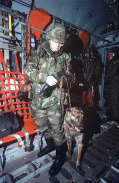
| Army military policewoman Spc. Colleen J. Neubest, disembarks
from an aircraft with her 4-year-old Dutch Shepherd police dog,
Fedor, at Tuzla Air Base, Bosnia. Fedor's specialty is detecting
drugs. Staff Sgt. John E. Lasky, USAF
|
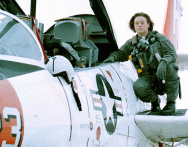
| First Lt. Keri Lynn Schubert is the first woman Marine
selected for naval flight officer duty in the F/A-18D Hornet.
Petty Officer 2nd Class Davis Rush, USN
|

| An unidentified co-pilot watches C-130 pilot Capt. Bly Blaser
fill out flight information before an Operation Joint Guard
mission from Tuzla Air Base, Bosnia, to Ramstein Air Base,
Germany. Airman 1st Class Greg L. Davis, USAF
|
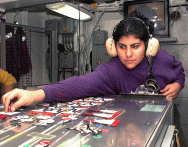
| Airman Mirna Gonzales updates a flight deck status report
aboard the aircraft carrier USS Nimitz during Operation Southern
Watch in the Persian Gulf. Petty Officer 3rd Class Cynthia R.
Zarate, USN
|

| Air traffic controller Petty Officer 2nd Class Jamie Bradley
works at the Carrier Air Traffic Control Center aboard the
aircraft carrier USS Kitty Hawk while en route to the Persian
Gulf. Petty Officer 3rd Class Mark Hamilton, USN
|
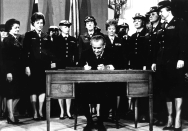
| President Lyndon B. Johnson signs Public Law 90-130. The Nov.
8, 1967, event opened promotions for women to general and flag
ranks, lifted ceilings on other ranks and removed the 2 percent
ceiling on the number of women allowed on active duty. Courtesy
Women's Memorial
|
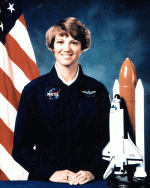
| Air Force Lt. Col. Eileen Collins became the first woman pilot
of a space shuttle, the Discovery, in February 1995. NASA photo
|
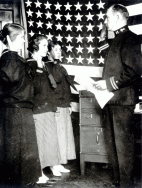
| Three women are sworn into the ranks of Navy yeomen in a Los
Angeles recruiting office in 1917. National Archives photo
|
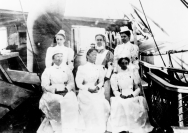
| Nurses serve aboard the U.S. Army Hospital Ship Relief in
Cuban waters in 1898. The ship was renamed the USS Relief in
1908 and served until 1919. Naval Historical Center photo
|
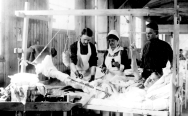
| An Army nurse assists with treatment of a patient during World
War I. Army Nurse Corps photo
|
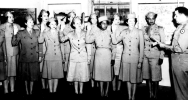
| A group of Women Army Auxiliary Corps members are sworn into
the Women's Army Corps at Fort Custer, Mich., in 1943. Courtesy
Women's Memorial
|
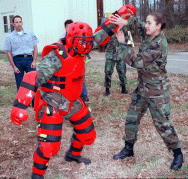
| Navy Petty Officer 2nd Class Arlland S. Ibit wears the
"Red Man" suit to aid Petty Officer 3rd Class Dana D.
Bogart in demonstrating self-defense techniques. Ibit is
assistant coordinator of the Auxiliary Security Force at Naval
Air Station Oceana, Va. Petty Officer 2nd Class Robbie E.
Russell, USN
|
|